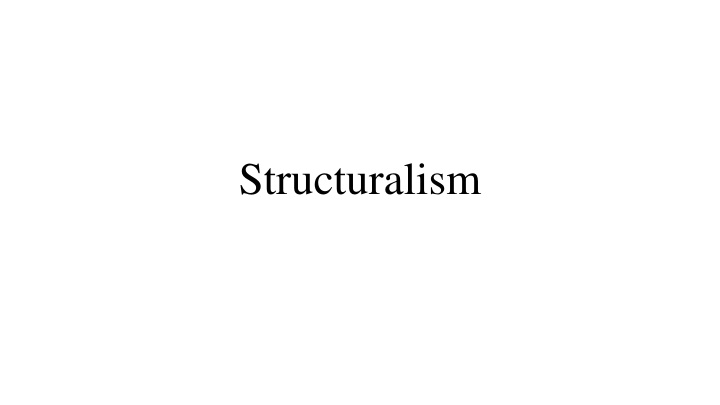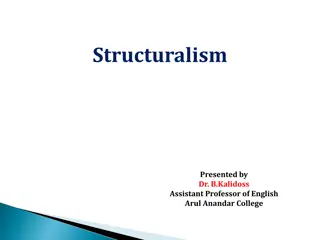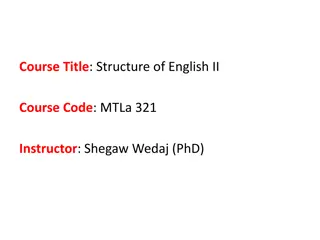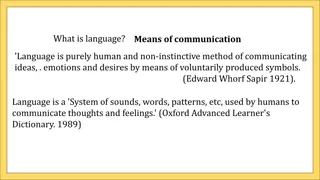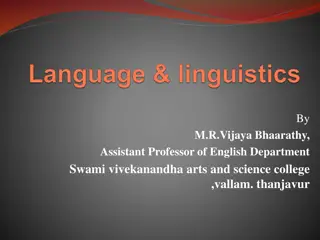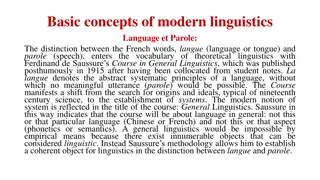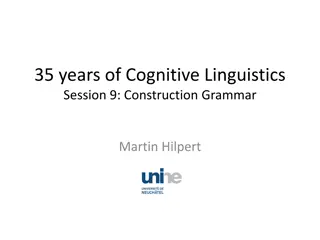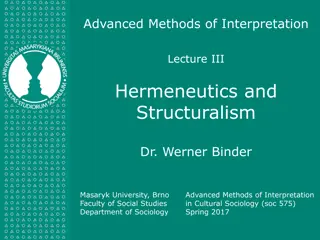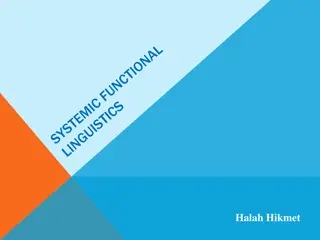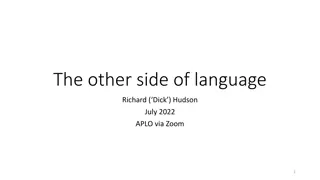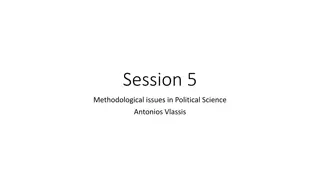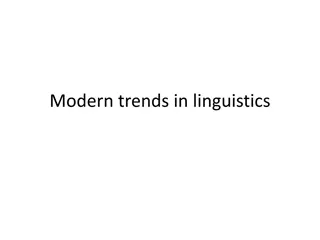Structuralism in Linguistics: An Overview
Structuralism emerged as a dominant approach in linguistic studies from the 1920s to the 1960s, led by figures like Ferdinand de Saussure. This philosophical perspective focused on the study of language as a stable system of signs, emphasizing the interrelation of mental representations of sounds and concepts. Structuralism highlighted the distinction between langue (language system) and parole (individual speech) and emphasized the arbitrariness of linguistic signs. It prioritized the formal structure of language over cultural history, psychology, or social interaction, marking a significant shift in linguistic theory.
Download Presentation

Please find below an Image/Link to download the presentation.
The content on the website is provided AS IS for your information and personal use only. It may not be sold, licensed, or shared on other websites without obtaining consent from the author.If you encounter any issues during the download, it is possible that the publisher has removed the file from their server.
You are allowed to download the files provided on this website for personal or commercial use, subject to the condition that they are used lawfully. All files are the property of their respective owners.
The content on the website is provided AS IS for your information and personal use only. It may not be sold, licensed, or shared on other websites without obtaining consent from the author.
E N D
Presentation Transcript
Language Both in North America and in Europe Structuralism took root in the study of language in the 1920s, remained the dominant approach until the 1960s (with many variations). The 20th century witnessed a linguistic turn. Revival of philosophical interest in language: accumulating knowledge about different languages (19th century studies in historical linguistics), but no serious attempt at a general theory of language.
Structuralist Linguistics - Saussure Ferdinand de Saussure (1857-1913) Moved from his special concerns with Indo-European or Germanic languages and given courses of lectures at Geneva in General Linguistics. In 1916, three years after his death, two of his former students published under his name a Course in General Linguistics. Rebelled against the dominant historical and genetic approach of 19th century linguistics, promoted a synchronic as opposed to a diachronic approach structuralism typically the study of constants in a stable corpus that is seen as forming a system.
Reduction Study of language NOT cultural history, psychology, the study of social interaction, or stylistic evaluation BUT a study of the linguistic core: the systematic interrelation of the mental representation of sounds and mental concepts (signs).
Language as an abstract system of signs Language is also the possession of society, which is another name for the 'collective consciousness', never the possession of an individual. Langue (language) vs. parole (speech): langue is the 'system' of language stored in the 'collective consciousness'. Grammar + full vocabulary. The langue thus comprises a full catalogue of the elements of a language together with the rules for their combination. Parole is the actual utterance of an individual (in speech or writing). Basic unit is the word in its function as linguistic sign. Sign composed of 'signifier' and 'signified' [not the same as referent]. Both these aspects, be it noted, are mental, for the good reason that they are indissoluble; the sign is a unity and its two aspects exist in total dependence one on the other.
Arbitrariness Linguistic signs are 'arbitrary', its form is not determined or 'motivated' by the thing it is the sign of, or referent. It establishes the autonomy of language in respect of reality. Value of sign matters, not its meaning (in the sense of reference). Think of chess pieces or gestures or phonemes. language is a system of differences. No sign is sufficient unto itself: it is what it is, linguistically, by virtue of what it isn't. What about epistemological, ideological, stylistic, etc. questions? Real but second order issues (dealt with by other departments.)
StructuralistAnthropology Claude L vi-Strauss (1908-2009) In the winter of 1942 he, an exile from occupied France, found himself in New York and lecturing at the same institution as Jakobson, an exile now from occupied Prague. Listening to what Jakobson had to say about phonology, and in particular about the analysis of phonemes into opposed pairs of 'distinctive features'. A society is essentially a synchronic system, to be studied in its present configuration: in this it is exactly the same as a language as Saussure defines it.
Deep structures Where the empiricist tradition accumulates data which seem to confirm the endless diversity of social practices, between one society and another, L vi-Strauss claims that the same data can be used, in ever more abstract ways, to reveal the fundamental unity [and equality] of all cultures. Each practice is a part whose 'value' lies in the place it can be shown to occupy within the whole. Not about individual behaviour. It seeks the systematic sets of rules on which a society's collective behaviour ultimately rests.
Systematic, holistic and universalist Structuralism works against any condescending assumption that some aspects of social behaviour are insignificant, because its principles force it to take an interest in everything [anticipates cultural studies]. "The customs of a people as a whole are always marked by a style: they form systems. I am convinced that these systems do not exist in unlimited numbers, and that human societies, like individuals - in their games, their dreams or their fantasies - never create in an absolute sense, but limit themselves to choosing certain combinations from an ideal repertoire which it would be possible to reconstitute. By drawing up an inventory of all the customs that had been observed, all those imagined in myths one would be able to draw up a periodic table like that of the chemical elements, in which all real or merely possible customs would appear grouped in families, and in which we would simply need to recognize those which societies have in fact adopted.
Kinship Levi-Strauss believed that he could provide a parallel for the phoneme from the anthropological world, and that was the 'incest taboo' or proscription of sexual relations with near kinsfolk which he assumes to be common to all societies. The incest taboo is for Levi-Strauss the point at which culture takes over from nature, or from mere biology, leading as it does to marriage outside the immediate family group and to the institution of a 'network of exchange' in which the items offered for exchange are women.
Mythology Contradiction: anything is likely to happen but there is significant similarity between myths collected in widely different regions. This points to an underlying structure common to myths everywhere: and that is the structure Levi-Strauss believes he has revealed in his analyses of myths. The technique he adopts is relatively simple, being to divide each myth up into its constituent elements or 'mythemes', to classify these 'mythemes' in terms of their 'function' within the myth and finally to relate the various classes of function to one another in an overall explanation of the structure of the myth.
Structuralist History Counter-intuitive, because structuralism is supposed to be about relatively stable, synchronic systems, but also bec. of the "great men approach to history. Here history makes men an women. Where historians may have looked in the past mainly for 'events', the structuralist looks for the system within which those events happened and by reference to which their historical value may be assessed. Historiography has moved closer to social anthropology, and historians have come to see that it is possible to study a given society or human group at a given moment in the past as a community of the coexistent.
Michel Foucault (1926-1984) Consistently rejected the structuralist label. While he used many of structuralism s signature methods, he was also the maverick the nobody quite managed to categorise. The historian is an archeologist: instead of interpreting past phenomena, she should try to display the system and the connection within it (like a structuralist linguist on signs). However, the archive is never complete, we possess merely fragments of any past situation, and it is essential to be explicit about the limitations. F. always ultimately interested in how power works in society has contemporary bearings (e.g. histories of institutions).
Episteme In The Order of Things (1966): a way of characterizing particular historical periods according to the manner in which they made sense of the world around them. These are the unconscious rules behind what sort of questions are discussed (taken seriously), especially in science. Not the great innovators' insights, but the general situation that enables those insights. Non-subjective and wildly inter-disciplinary. Hyper-conscious of it s own limitations.
Structuralism in the Study of Literature Roland Barthes (1915-1980) Perhaps the most influential promoter of the linguistic model in the wider cultural field. Structural account of the universe of Racine's tragedies in Sur Racine (1963); a systematic account of Saussure's proposed new science in Elements de semiologie (1964); a linguistic model for the analysis of all narratives in 'Introduction a l'analyse structurale des recits' (1966); semiological analysis of fashion in Systeme de la mode (1967); S/Z (1970) Saussurean analysis of a literary text to a new extreme of detail.
Writerly and Readerly Texts A readerly text demands little of the reader, who merely conforms to conventions and is in the process made comfortable. A writerly text demands much of the reader, whose expectations may be frustrated and who may feel discomfort.
Death of theAuthor / Birth of the Reader The author still reigns in histories of literature, biographies of writers, interviews, magazines, as in the very consciousness of men of letters anxious to unite their person and their work through diaries and memoirs. The image of literature to be found in ordinary culture is tyrannically centred on the author, his person, his life, his tastes, his passions, while criticism still consists for the most part in saying that Baudelaire s work is the failure of Baudelaire the man, Van Gogh s his madness, Tchaikovsky s his vice. The explanation of a work is always sought in the man or woman who produced it, as if it were always in the end, through the more or less transparent allegory of the fiction, the voice of a single person, the author confiding in us.
Death of the Author / Birth of the Reader 2 Once the Author is removed, the claim to decipher a text becomes quite futile. To give a text an Author is to impose a limit on that text, to furnish it with a final signified, to close the writing. Such a conception suits criticism very well, the latter then allotting itself the important task of discovering the Author (or its hypostases: society, history, psyche, liberty) beneath the work: when the Author has been found, the text is explained victory to the critic. In the multiplicity of writing, everything is to be disentangled, nothing deciphered; the structure can be followed, run (like the thread of a stocking) at every point and at every level, but there is nothing beneath: the space of writing is to be ranged over, not pierced; writing ceaselessly posits meaning ceaselessly to evaporate it, carrying out a systematic exemption of meaning.
Death of the Author / Birth of the Reader 3 a text is made of multiple writings, drawn from many cultures and entering into mutual relations of dialogue, parody, contestation, but there is one place where this multiplicity is focused and that place is the reader, not, as was hitherto said, the author. The reader is the space on which all the quotations that make up a writing are inscribed without any of them being lost; a text s unity lies not in its origin but in its destination .the birth of the reader must be at the cost of the death of the Author.
Michel Foucault: What is an Author? (1969/70) four characteristics of the author function. 1. The author function is linked to the legal system and arises as a result of the need to punish those responsible for transgressive statements (e.g. obscene writers). 2. The author function does not affect all texts in the same way. For example, it doesn't seem to affect scientific texts as much as it affects literary texts. 3. The editorial problem of attribution: the problem of deciding whether or not a given text should be attributed to a particular author. 4. The term author doesn't refer purely and simply to a real individual. The "author" is much like the narrator, Foucault suggests, in that he or she can be an "alter ego" for the actual flesh-- and-- blood writer.
Michel Foucault: What is an Author? 2 We are accustomed, as we have seen earlier, to saying that the author is the genial creator of a work in which he deposits, with infinite wealth and generosity, an inexhaustible world of significations. We are used to thinking that the author is so different from all other men, and so transcendent with regard to all languages that, as soon as he speaks, meaning begins to proliferate, to proliferate indefinitely. The truth is quite the contrary: the author is not an indefinite source of significations which fill a work; the author does not precede the works, he is a certain functional principle by which, in our culture, one limits, excludes, and chooses; in short, by which one impedes the free circulation, the free manipulation, the free composition, decomposition, and recomposition of fiction.
Michel Foucault: What is an Author? 3 I think that, as our society changes, at the very moment when it is in the process of changing, the author-function will disappear, and in such a manner that fiction and its polysemic texts will once again function according to another mode, but still with a system of constraint one which will no longer be the author, but which will have to be determined or, perhaps, experienced. All discourses, whatever their status, form, value, and whatever the treatment to which they will be subjected, would then develop in the anonymity of a murmur.
General Features of Literary Structuralism Emphasis not on literature as self-expression but on 2 objective systems of signs. 1) language itself, 2) 'literary' conventions. In search of the langue of which each individual literary work is the parole. Aristotelian (like Formalism) in trying to understand the literary conventions and focusing on how literature is crafted. Both Formalism and Structuralism start from an 'immanent' view of the meaning of literary works. That is, they attempt to exclude from consideration whatever is external to the text or texts they are studying.
General Features 2 Jakobson s poetic function: fixes the attention of the two parties to the communicative act - speaker and hearer; writer and reader - on the actual words which are being used. The focus is on the message, for its own sake language is 'foregrounded'. With the poetic function comes a certain opacity, for the writer is no longer passing information nor seeking to instigate action. Formalism: isolated 'devices', rather investigating complete structures. Wholes are comparable with other wholes (different works by the same author, works by different authors within the same genre). Wider applications of Structuralism, extensible if need be to whole cultures.
Roots of Narratology Vladimir Propp, The Morphology of the Russian Folk-tale (1928). Folktales: simplicity, the narrative is all-important, stereotyped in terms of events and characters, and they are anonymous (comparable to the myths analysed by L vi-Strauss). Propp's method is to divide the tales up into 'functions' : structuralist task of abstraction and generalization. A 'function' is an action seen as lending itself to assimilation to other, comparable actions elsewhere in the corpus of tales. From a limited number of 'functions' an enormous variety of tales can be generated (as in linguistics).
Roots of Narratology 2 You can list not only the underlying units of action but also the "7 act spheres": Aggressor, Donor, Auxiliary, Princess and the father, Committer, Hero, Bogus hero. Algirdas Julien Greimas: distinction (Semantique structurale, 1966) between actant and an actor. Actants are purely formal elements in a narrative, equivalent to the subject and object of a grammarian, they have no names, no qualities and no meaning beyond their grammatical role. They include: Subject (looking for the Object), Object (looked for by the Subject), Sender (of the Subject on its quest for the Object), Receiver (of the Object to be secured by the Subject), Helper (of the Subject), and Opponent (of the Subject).
Narratological Categories 1 G rard Genette, et al., mostly the 1970s and 80s Three levels of narrative focalization: zero focalization (which is a classic narrative form in which the narrator knows more than the character ); internal focalization (in which the narrator says only what a given character knows ), which can be either fixed (as in Joyce s Portrait), variable (as in Madame Bovary or Woolf s Mrs. Dalloway), or multiple (as in the epistolary novel); and external focalization ( in which the narrator says less than the character knows, as in Hemingway s The Killers ). Thus internal focalization is associated with character and external focalization with an anonymous agent, situated outside the fabula, that is, a non- character-bound focalizer .
Narratological Categories 2 Temporal orders that a narrative text can follow, the anachronies (flashbacks or flashforwards) that it can exhibit, the achronic (undatable) structures that it can accommodate. Narrative speed and its canonical tempos: ellipsis, summary, scene, stretch, pause. Narrative frequency: singulative narrative (I recount once what happened once), repeating narrative (I recount more than once what happened once), iterative narrative (I recount once what happened more than once).
